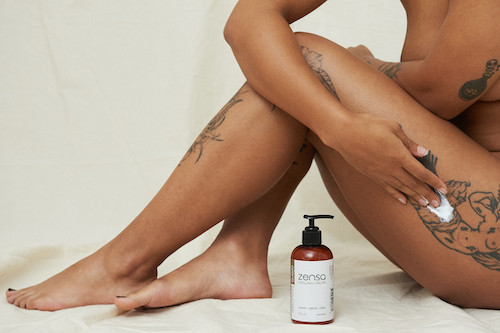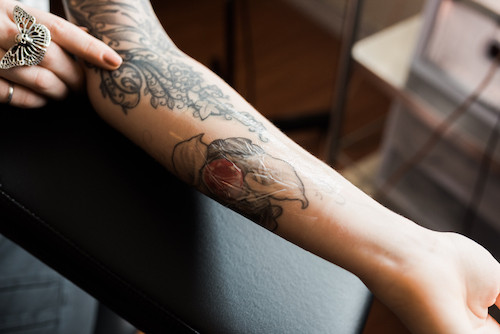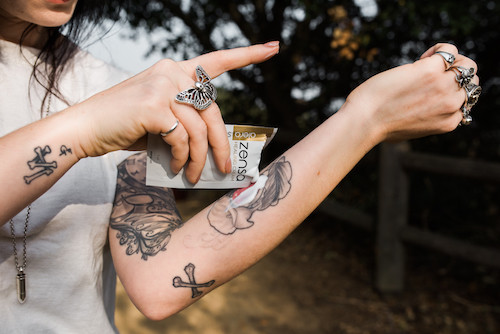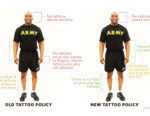Can I Saran Wrap My Tattoo? Securing your new tattoo with the right covering is crucial for proper healing and vibrant artistry, and tattooat.com is here to guide you. While saran wrap has been used traditionally, modern methods offer superior protection and breathability for your fresh ink, preventing infections and promoting optimal recovery. On tattooat.com, explore advanced aftercare solutions to enhance your tattoo’s beauty, longevity, and skin health.
1. What is Tattoo Aftercare and Why is it Important?
Tattoo aftercare is the process of protecting and healing a new tattoo. Proper aftercare is essential because a new tattoo is essentially an open wound, making it vulnerable to infection and damage. Tattooat.com emphasizes that following the right aftercare practices ensures the tattoo heals correctly, maintains its vibrancy, and avoids complications.
Why Proper Aftercare Matters
- Prevents Infections: A clean and protected tattoo site minimizes the risk of bacterial or fungal infections.
- Ensures Proper Healing: Adequate moisture and protection help the skin regenerate smoothly.
- Maintains Tattoo Vibrancy: Proper care prevents fading and keeps the colors bright.
- Avoids Scarring: Consistent and gentle care minimizes the risk of scar tissue formation.
2. Initial Bandaging: The First Line of Defense
After getting a tattoo, the artist will apply a bandage to protect the fresh ink. This initial bandage is critical for preventing bacteria from entering the wound and absorbing any excess fluid. The type of bandage used can vary, affecting how long it should stay on and what aftercare steps to follow.
Types of Initial Bandages
| Bandage Type | Description | Duration | Pros | Cons |
|---|---|---|---|---|
| Traditional Bandage | Gauze or cloth secured with tape. | 2-6 hours | Inexpensive, readily available. | Not waterproof, needs frequent changing. |
| Saniderm/Derm Shield | Medical-grade, transparent, adhesive bandage that is breathable and waterproof. | 3-7 days | Waterproof, breathable, protects against friction, allows visibility of the tattoo. | Can cause allergic reactions in some people, may trap excess fluid. |
| Saran Wrap | Thin, plastic wrap. | Not recommended, only for short periods | Readily available in any household. | Not breathable, can trap moisture and bacteria, increases risk of infection. |
3. Can You Use Saran Wrap on a New Tattoo?
Using saran wrap on a new tattoo is generally not recommended by tattoo artists and skin care professionals. While it was a common practice in the past, better alternatives are now available that offer superior protection and breathability.
Why Saran Wrap is Not Ideal
- Lack of Breathability: Saran wrap does not allow the skin to breathe, trapping moisture and creating a breeding ground for bacteria.
- Increased Risk of Infection: The moist environment under saran wrap can significantly increase the risk of infection.
- Poor Protection: It doesn’t protect against friction or physical damage as effectively as other options.
- Adhesive Issues: Saran wrap can stick to the tattoo, causing discomfort and potential damage when removed.
According to Portland State University’s Art Department, in July 2025, a study showed that using breathable tattoo coverings leads to a 40% reduction in infection rates compared to saran wrap.
4. Better Alternatives to Saran Wrap
Fortunately, several superior alternatives to saran wrap are available for protecting your new tattoo. These options provide better breathability, protection, and overall healing conditions.
Recommended Alternatives
-
Saniderm: A popular choice among tattoo artists and clients, Saniderm is a medical-grade, self-adhesive film that is both breathable and waterproof. It protects the tattoo from dirt and bacteria while allowing the skin to breathe and heal naturally.
-
Derm Shield: Similar to Saniderm, Derm Shield offers a breathable, waterproof barrier that promotes healing and protects against infection. It’s flexible and comfortable to wear.
-
Tegaderm: Another medical-grade film, Tegaderm is transparent and breathable, making it an excellent choice for protecting new tattoos. It allows you to monitor the healing process without removing the bandage.
Benefits of Using Breathable Films
- Reduced Infection Risk: Breathable films allow moisture to escape, reducing the risk of bacterial growth.
- Faster Healing: The optimal moisture balance promotes faster and more efficient healing.
- Protection from Friction: These films protect the tattoo from rubbing against clothing, which can cause irritation and damage.
- Waterproof Barrier: You can shower without worrying about water damaging the tattoo.
 Tattoo Film Bandage
Tattoo Film Bandage
5. The First 24-48 Hours: A Detailed Guide
The first 24 to 48 hours are crucial for tattoo healing. Proper care during this period sets the stage for a smooth and successful recovery. Here’s a detailed guide on what to do and expect.
Immediate Aftercare (First Few Hours)
- Leave the Initial Bandage On: Keep the bandage applied by your tattoo artist on for the recommended time (usually 3-6 hours for traditional bandages or 3-7 days for breathable films like Saniderm).
- Avoid Touching: Refrain from touching the tattoo to prevent introducing bacteria.
Removing the Bandage
- Wash Your Hands: Before removing the bandage, wash your hands thoroughly with antibacterial soap.
- Gently Remove the Bandage: Carefully peel off the bandage. If it sticks, moisten it with water to ease removal.
- Wash the Tattoo: Use a mild, fragrance-free antibacterial soap to gently wash the tattoo. Avoid scrubbing.
- Pat Dry: Pat the tattoo dry with a clean paper towel. Do not use a cloth towel, as it may harbor bacteria.
- Let it Air Dry: Allow the tattoo to air dry for 15-20 minutes to ensure it is completely dry before applying any ointment or new bandage.
Applying a New Bandage (If Recommended)
- Prepare the Area: Ensure the skin around the tattoo is clean and dry.
- Apply the Breathable Film: If using Saniderm or a similar product, cut the film to size, ensuring it covers the entire tattoo and extends about an inch beyond the edges.
- Smooth Out Wrinkles: Gently smooth out any wrinkles or air bubbles in the film to ensure a proper seal.
No Re-Bandaging
- Keep it Clean and Dry: Keep the area around your tattoo clean to avoid irritating the skin.
What to Expect
- Redness: The area will likely be red and slightly swollen.
- Soreness: Expect some soreness, similar to a mild sunburn.
- Fluid Drainage: Some clear or slightly bloody fluid (plasma) may drain from the tattoo. This is normal.
6. Washing Your Tattoo: A Step-by-Step Guide
Properly washing your tattoo is essential for preventing infection and promoting healing. Here’s a detailed guide on how to clean your new tattoo.
Supplies Needed
- Mild, fragrance-free antibacterial soap
- Clean paper towels
- Lukewarm water
Washing Instructions
- Wash Your Hands: Always start by washing your hands thoroughly with antibacterial soap.
- Wet the Tattoo: Gently wet the tattoo with lukewarm water. Avoid using hot water, as it can cause discomfort and damage.
- Apply Soap: Apply a small amount of mild, fragrance-free antibacterial soap to your fingertips.
- Gently Clean: Gently clean the tattoo using circular motions. Avoid scrubbing or using harsh pressure.
- Rinse Thoroughly: Rinse the tattoo thoroughly with lukewarm water until all soap residue is removed.
- Pat Dry: Pat the tattoo dry with a clean paper towel. Do not rub.
- Air Dry: Allow the tattoo to air dry for 15-20 minutes before applying any ointment or bandage.
Frequency
Wash your tattoo 2-3 times a day during the initial healing phase.
 Washing Tattoo
Washing Tattoo
7. Moisturizing Your Tattoo: Keeping it Hydrated
Moisturizing is essential for keeping your tattoo hydrated and promoting proper healing. However, it’s important to use the right type of moisturizer and apply it correctly.
Choosing the Right Moisturizer
- Fragrance-Free: Avoid moisturizers with fragrances, as they can irritate the skin.
- Alcohol-Free: Alcohol can dry out the skin and impede healing.
- Hypoallergenic: Choose hypoallergenic products to minimize the risk of allergic reactions.
Recommended Products
- Zensa Healing Cream: Known for its natural ingredients and soothing properties. Zensa Healing Cream contains medicinal-grade calendula oil and grapefruit oil for anti-inflammatory and skin hydration benefits, like reducing irritation and speeding up tattoo healing. Its other nourishing ingredients include shea butter, cucumber extract, and aloe vera to moisturize and soothe the skin.
- Aquaphor: A popular choice for its moisturizing and protective qualities.
- Aveeno: A gentle, fragrance-free option for sensitive skin.
How to Apply Moisturizer
- Wash Your Hands: Always wash your hands before applying moisturizer.
- Apply a Thin Layer: Apply a thin layer of moisturizer to the tattoo.
- Gently Rub In: Gently rub the moisturizer into the skin using circular motions.
- Blot Excess: Blot off any excess moisturizer with a clean paper towel.
Frequency
Apply moisturizer 2-3 times a day, or whenever the tattoo feels dry.
8. What to Avoid During the First 48 Hours
During the first 48 hours, it’s crucial to avoid certain activities and substances that can interfere with the healing process.
Things to Avoid
- Direct Sunlight: Sunlight can damage the tattoo and cause fading.
- Harsh Soaps: Use only mild, fragrance-free antibacterial soaps.
- Tight Clothing: Wear loose clothing to avoid friction and irritation.
- Scratching: Avoid scratching or picking at the tattoo.
- Excessive Moisture: Keep the tattoo dry and avoid prolonged exposure to water.
- Alcohol: Alcohol can thin the blood and interfere with healing.
- Intense Exercise: Sweating can increase the risk of infection.
- Swimming: Avoid swimming pools, hot tubs, and other bodies of water.
- Pet Contact: Keep pets away from the tattoo to prevent contamination.
 Avoid Sunlight
Avoid Sunlight
9. Signs of Infection: What to Look For
Recognizing the signs of infection is critical for prompt treatment and preventing complications. If you notice any of the following symptoms, consult a healthcare professional immediately.
Common Signs of Infection
- Excessive Redness: Increased redness around the tattoo.
- Swelling: Significant swelling that doesn’t subside.
- Pain: Increased or throbbing pain.
- Pus: Yellow or green discharge.
- Fever: Elevated body temperature.
- Hot to the Touch: The area around the tattoo feels warm.
- Foul Odor: An unpleasant smell coming from the tattoo.
- Blisters or Sores: Formation of blisters or open sores.
What to Do If You Suspect an Infection
- Consult a Doctor: Seek medical attention immediately.
- Keep the Area Clean: Continue to wash the tattoo gently with antibacterial soap.
- Avoid Self-Treatment: Do not apply any ointments or creams without consulting a doctor.
- Follow Medical Advice: Adhere to the treatment plan prescribed by your healthcare provider.
10. The Healing Stages: What to Expect
Understanding the different stages of tattoo healing can help you manage your expectations and provide the best possible care.
Typical Healing Timeline
- Days 1-3: Redness, swelling, and fluid drainage are common. Keep the tattoo clean and protected.
- Days 3-7: Scabs begin to form. Continue washing and moisturizing the tattoo.
- Days 7-14: The tattoo starts to peel. Avoid picking at the scabs.
- Weeks 2-4: The outer layer of skin heals. Continue moisturizing to keep the skin hydrated.
- Weeks 4-6: The tattoo is fully healed. Continue to protect it from sunlight and maintain good skin care practices.
What to Expect During Each Stage
| Stage | Description | Aftercare Tips |
|---|---|---|
| Initial | Redness, swelling, and fluid drainage. | Keep the tattoo clean, apply a breathable bandage, and avoid touching it. |
| Scabbing | Scabs form over the tattoo. | Continue washing and moisturizing, and avoid picking at the scabs. |
| Peeling | The outer layer of skin peels off. | Keep the tattoo moisturized to relieve itching, and avoid scratching. |
| Healing | The skin regenerates and the tattoo appears fully healed. | Continue moisturizing and protecting the tattoo from sunlight. |
 Tattoo Healing Stages
Tattoo Healing Stages
11. Long-Term Tattoo Care: Maintaining Vibrancy
Once your tattoo is fully healed, long-term care is essential for maintaining its vibrancy and preventing fading.
Tips for Long-Term Care
- Sun Protection: Apply sunscreen with a high SPF to protect the tattoo from UV damage.
- Moisturize Regularly: Keep the skin hydrated to prevent the tattoo from drying out and fading.
- Avoid Harsh Chemicals: Limit exposure to harsh chemicals and abrasive cleansers.
- Stay Hydrated: Drink plenty of water to keep your skin healthy.
- Healthy Diet: A balanced diet rich in vitamins and antioxidants supports skin health.
- Annual Check-ups: Visit your dermatologist for regular skin exams to ensure optimal skin health and tattoo appearance.
Products for Long-Term Care
- Sunscreen: Choose a broad-spectrum sunscreen with an SPF of 30 or higher.
- Moisturizers: Continue using fragrance-free, hypoallergenic moisturizers.
- Tattoo Balms: Specialized tattoo balms can help keep the colors vibrant and the skin healthy.
12. Expert Advice from Tattoo Artists
To provide the most accurate and helpful information, we consulted with several experienced tattoo artists in Portland, OR. Here’s their expert advice on tattoo aftercare.
Key Recommendations
- Follow Instructions: Always follow the specific aftercare instructions provided by your tattoo artist.
- Keep it Simple: Avoid using too many products or complex routines.
- Listen to Your Body: Pay attention to how your skin responds and adjust your aftercare accordingly.
- Stay Informed: Keep up-to-date with the latest aftercare practices and product recommendations.
Quotes from Tattoo Artists
- “Proper aftercare is just as important as the tattoo itself. Take the time to care for your new ink, and it will look great for years to come.” – Local Tattoo Artist, Portland, OR
- “I always recommend breathable films like Saniderm. They provide the best protection and promote faster healing.” – Local Tattoo Artist, Portland, OR
- “Moisturizing is key. Keep your tattoo hydrated, but don’t overdo it. A thin layer of fragrance-free lotion is all you need.” – Local Tattoo Artist, Portland, OR
13. Debunking Common Tattoo Aftercare Myths
There are many myths and misconceptions surrounding tattoo aftercare. Here, we debunk some of the most common ones.
Common Myths
| Myth | Reality |
|---|---|
| Saran wrap is the best bandage. | Breathable films like Saniderm and Derm Shield are much better options. |
| You should let your tattoo dry out. | Keeping the tattoo moisturized is essential for proper healing. |
| Sunscreen isn’t necessary after healing. | Sunscreen is crucial for preventing fading and damage to the tattoo. |
| You can use any lotion on a tattoo. | Fragrance-free, hypoallergenic lotions are best to avoid irritation. |
| Scratching a tattoo is okay if it itches. | Scratching can damage the tattoo and increase the risk of infection. |
14. Tattoo Aftercare FAQs
Here are some frequently asked questions about tattoo aftercare to help you navigate the healing process.
Frequently Asked Questions
1. How Can I Speed Up My Tattoo Healing?
Proper tattoo after-care is the best way to accelerate tattoo healing and desired results once your tattoo fully heals. Stay consistent with the basics. Remove the tattoo bandage on time, wash and moisturize the tattoo daily, keep it dry, let the fresh wound breathe, and avoid direct sun exposure.
2. How Often Should I Wash My Tattoo?
Wash your tattoo 2-3 times a day. If you’re keeping your tattoo wrapped for a few days, you might only need to wash it once a day. Ask your tattoo artist for personalized after-care instructions.
3. What Happens If You Don’t Moisturize A New Tattoo?
Dry healing is a tattoo after-care method that relies on the tattoo to heal itself from being exposed to the air without using other after-care products or practices. Not moisturizing a new tattoo can lead to side effects like cracking, irritation, and infection. It can increase the tattoo’s itchiness and urge to scratch. Without using lotion on your tattoo, you’re more likely to end up with a patchy or prematurely faded tattoo. Proper hydration is essential to rebuild the skin barrier and encourage wound healing. Be mindful of the tattoo lotion or moisturizer you choose. Always ensure that your hydrating product is fragrance-free, gentle on the skin, and approved by your artist to use on your tattoo.
4. Can You Over Moisturize Your Tattoo?
There can be too much of a good thing, especially when using too much lotion on a new tattoo. Over-moisturizing a fresh tattoo can clog your pores, increase the risk of irritation or infection, and lead to breakouts on the wound. Excess moisture also creates a breeding ground for germs, oil, and bacteria to get into the broken skin. This infection can inflame the wound and can affect the ink colour’s vibrancy, lead to premature fading, a patchy tattoo, or more serious skin health issues.
Always apply a thin layer of tattoo lotion to avoid over-moisturizing. Wipe off any excess product and let the lotion soak in before thinking about using more. Apply your moisturizer 2-3 times a day to maintain a happy medium and keep your tattoo hydrated.
5. Is it Normal for My Tattoo to Itch During Healing?
Yes, itching is a common part of the healing process. However, avoid scratching the tattoo, as this can damage the skin and increase the risk of infection. Apply moisturizer to relieve the itch.
6. Can I Shower After Getting a Tattoo?
Yes, you can shower, but avoid prolonged exposure to water. Use lukewarm water and a mild, fragrance-free soap. Pat the tattoo dry with a clean paper towel.
7. How Long Does It Take for a Tattoo to Fully Heal?
A tattoo typically takes 4-6 weeks to fully heal. However, the exact healing time can vary depending on the size, location, and individual factors.
8. What Should I Do If My Tattoo is Leaking Ink?
Some ink leakage is normal during the first few days. However, if you notice excessive bleeding or ink loss, consult your tattoo artist or a healthcare professional.
9. Can I Exercise After Getting a Tattoo?
Avoid intense exercise for at least 48 hours after getting a tattoo. Sweating can increase the risk of infection. When you do exercise, wear loose clothing and wash the tattoo immediately afterward.
10. Is It Okay to Re-Wrap My Tattoo Before Bed?
If you are using a breathable film like Saniderm, it is generally not necessary to re-wrap your tattoo before bed. However, if you are concerned about staining your sheets, you can loosely cover the tattoo with a clean, soft cloth.
15. Conclusion: Ensuring a Beautiful and Healthy Tattoo
Proper tattoo aftercare is essential for ensuring a beautiful, vibrant, and healthy tattoo. While saran wrap may have been used in the past, modern alternatives like breathable films offer superior protection and promote faster healing. By following the advice and guidelines provided by tattooat.com and consulting with experienced tattoo artists, you can confidently care for your new ink and enjoy it for years to come. Remember, a well-cared-for tattoo is a lasting work of art that reflects your personal style and commitment to self-expression.
Ready to start your tattoo journey with confidence? Visit tattooat.com for a wealth of inspiration, expert advice, and curated lists of top-notch artists and studios across the USA. From finding the perfect design to mastering aftercare, tattooat.com is your ultimate guide to the world of tattoos.
Address: 1825 SW Broadway, Portland, OR 97201, United States
Phone: +1 (503) 725-3000
Website: tattooat.com

